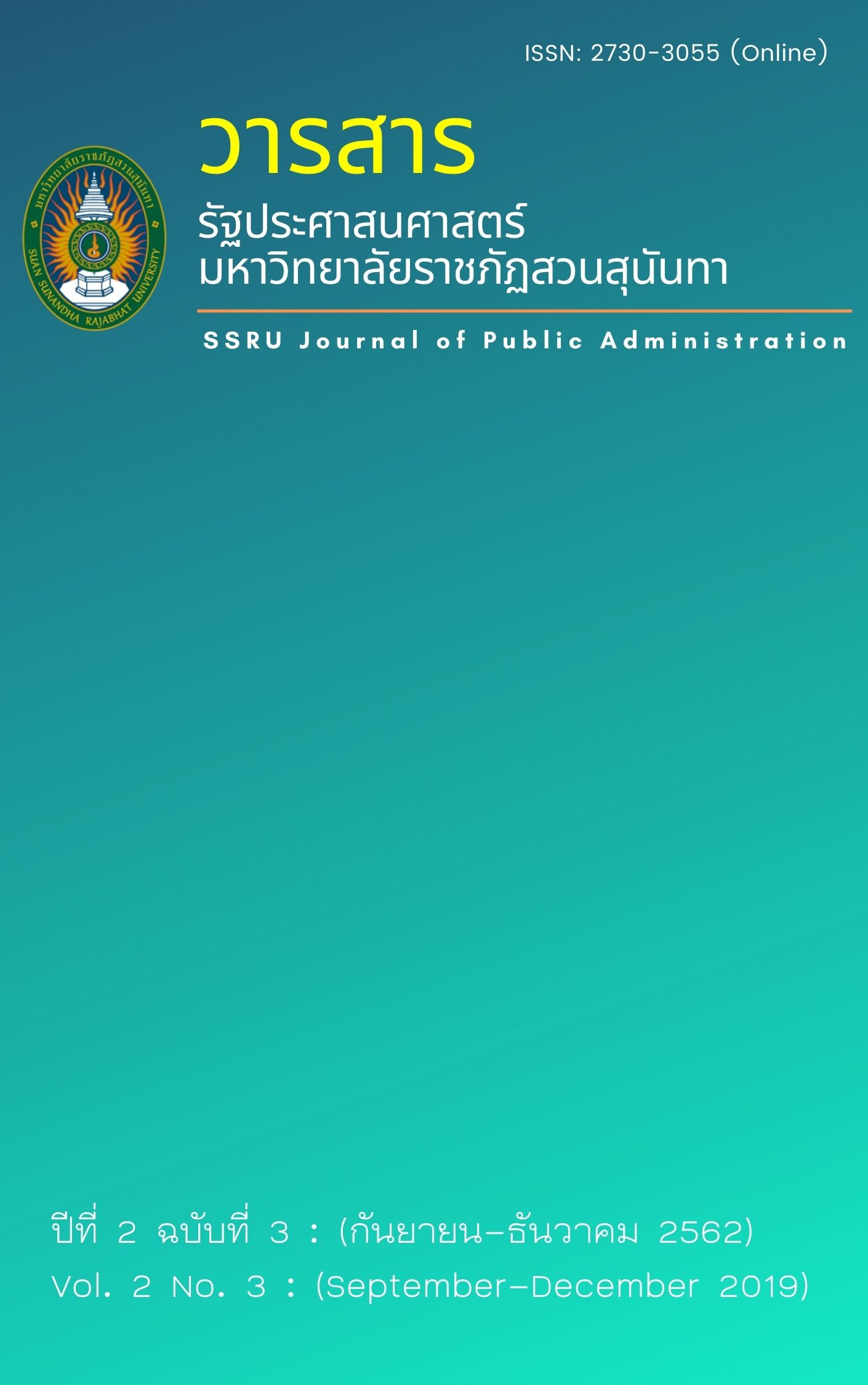บุพปัจจัยของความตั้งใจสนับสนุนสินค้าไทยของผู้บริโภคกลุ่มประเทศ CLMV
Main Article Content
บทคัดย่อ
การวิจัยครั้งนี้มีวัตถุประสงค์ เพื่อศึกษาอิทธิพลของคุณค่าตราสินค้า ภาพลักษณ์ประเทศแหล่งกำเนิดสินค้า สิ่งกระตุ้นทางการตลาด และ ความภาคภูมิใจในความเป็นชาติที่มีต่อความตั้งใจสนับสนุนสินค้าไทยการวิจัยนี้ใช้วิธีการวิจัยเชิงปริมาณ กลุ่มตัวอย่างคือ ผู้บริโภคในประเทศเวียดนาม และประเทศกัมพูชาที่มีประสบการณ์ใช้ผลิตภัณฑ์ที่มีแหล่งกำเนิดจากประเทศไทย จำนวน 400 คน ใช้วิธีการสุ่มตัวอย่างแบบหลายขั้นตอน เก็บข้อมูลด้วยแบบสอบถาม และวิเคราะห์ด้วยแบบจำลองสมการโครงสร้าง ผลการวิจัยพบว่า สิ่งกระตุ้นทางการตลาดมีอิทธิพลโดยรวมต่อความตั้งใจสนับสนุนสินค้าไทยของผู้บริโภคกลุ่มประเทศ CLMV มากที่สุด รองลงมา คือ คุณค่าตราสินค้า ความภาคภูมิใจในความเป็นชาติ และภาพลักษณ์ประเทศแหล่งกำเนิดสินค้า ตามลำดับ ผลของการวิจัยนี้ นักลงทุนชาวไทยสามารถนำข้อค้นพบมาใช้เป็นแนวทางในการบริหารจัดการการส่งออก รวมถึงการบริหารจัดการกลยุทธ์ส่วนประสมทางการตลาด และการสื่อสารข้อมูลข่าวสารต่าง ๆ เพื่อพัฒนาภาพลักษณ์และคุณค่าให้กับผลิตภัณฑ์ ตราสินค้าองค์กร รวมถึงประเทศไทย อันถือเป็นก้าวสำคัญในการส่งเสริมให้เกิดความตั้งใจที่จะสนับสนุนสินค้าไทยของผู้บริโภคชาวอาเซียนต่อไปในอนาคต ขณะที่กระทรวงพาณิชย์สามารถใช้ผลการศึกษาในการวางแผนและกำหนดนโยบายเพื่อส่งเสริมให้เกิดความตั้งใจที่จะสนับสนุนสินค้าไทยของผู้บริโภคชาวอาเซียน โดยเฉพาะอย่างยิ่งผู้บริโภคชาวเวียดนาม และผู้บริโภคชาวกัมพูชา ซึ่งถือได้ว่าเป็นตลาดสำคัญสำหรับนักธุรกิจไทยในการส่งออกไปสู่ตลาดอาเซียน
Article Details

อนุญาตภายใต้เงื่อนไข Creative Commons Attribution-NonCommercial 4.0 International License.
เอกสารอ้างอิง
ฐานเศรษฐกิจ. (2560). Deepening CLMV Urbanization เจาะลึกศักยภาพ 4 เมืองใหม่ เตรียมพร้อมสู่การลงทุนเต็มรูปแบบ. ค้นเมื่อ 10 พฤศจิกายน 2560, จากhttp://www.thansettakij.com/content/ 131904.
พิชญ์สินี ฐิติสมบูรณ์. (2558). ส่องโอกาส วางกลยุทธ์เจาะตลาด CLMV. สืบค้นเมื่อ 10 พฤศจิกายน 2560, จาก https://www.scbeic.com/th/detail/ product/1480.
Aaker, D. A. (1991). Managing brand equity: Capitalizing on the value of a brand name. New York: Free Press.
Aaker, D. A. (1996). Measuring brand equity across products and markets. California management review. 38(3): 102-120.
Abril, C., & Rodriguez-Cánovas, B. (2016). Marketing mix effects on private labels brand equity. European Journal of Management and Business Economics, 25(3): 168-175.
Ahmed, S. N. B., & Judhi, N. (2010). Organic food: A study on demographic characteristics and factors influencing purchase intentions among consumers in Klang Valley, Malaysia. International Journal of Business and Management. 5(2):105-118.
Ajzen, I. (1985). From intentions to actions: A theory of planned behavior. In Action control Springer, Berlin: Heidelberg.
Anic, D. (2010). Attitudes and purchasing behavior of consumers in domestic and foreign food retailers in Croatia. Journal of Economics and Business. 28(1): 113-133.
Bee Lian, S., Safari, M., & Mansori, S. (2016). The Effects of Marketing Stimuli Factors on Consumers’ Perceived Value and Purchase of Organic Food in Malaysia. Jurnal Pengurusan (UKM Journal of Management). 47:119-130.
Fishbein, M., & Ajzen, I. (1975). Belief, attitude, intention and behavior: An introduction to theory and research. Reading, MA: Addison-Wesley.
Kapferer, J. N. (2012). The new strategic brand management: Advanced insights and strategic thinking. Kogan page publishers, London: United Kingdom.
Keller, K. L.(1993).Conceptualizing, measuring, and managing customer-based brand equity. Journal of Marketing. 57(1): 1-22.
Keller, K. L. (2003). Brand synthesis: The multidimensionality of brand knowledge. Journal of consumer research. 29(4): 595-600.
Kline, R. B. (2005). Principle and practice of structural equation modeling. New York: Guilford.
Kock, N. & Hadaya, P. (2018). Minimum sample size estimation in PLS-SEM: The inverse square root and gamma-exponential methods. Information Systems Journal. 28(1): 227-261.
Kotler, P. (1997). Marketing Management Analysis, Planning, Implementation and Control. (9th ed.). New Jersey: A Simon & Schuster.
Laroche, M., Papadopoulos, N., Heslop, L. A., & Mourali, M. (2005). The influence of country image structure on consumer evaluations of foreign products. International Marketing Review. 22(1): 96-115.
Lee, D., & Ganesh, G. (1999). Effects of partitioned country image in the context of brand image and familiarity: A categorization theory perspective. International Marketing Review. 16(1): 18-41.
Lee, J. K., & Lee, W. N. (2009). Country-of-origin effects on consumer product evaluation and purchase intention: The role of objective versus subjective knowledge.Journal of International Consumer Marketing. 21(2): 137-151.
Lu Wang, C., & Xiong Chen, Z. (2004). Consumer ethnocentrism and willingness to buy domestic products in a developing country setting: testing moderating effects.Journal of Consumer Marketing. 21(6): 391-400.
Nadiri, H., & Tümer, M. (2010). Influence of ethnocentrism on consumers’ intention to buy domestically produced goods: an empirical study in North Cyprus.Journal of Business Economics and Management. 11(3): 444-461.
Orbaiz, L. V., & Papadopoulos, N. (2003). Toward a model of consumer receptivity of foreign and domestic products. Journal of International Consumer Marketing. 15(3): 101-126.
Sari, D., & Kusuma, B.(2014). Does luxury brand perception matter in purchase intention? A comparison between a Japanese brand and a German brand. ASEAN Marketing Journal. 4(1): 50-63.
Schiffman, L., & Kanuk, L., (2010).Consumer Behavior.(10th Edition). Upper Saddle River: Pearson Education.
Sharma, S., Shimp, T. A., & Shin, J. (1994). Consumer ethnocentrism: A test of antecedents and moderators. Journal of the academy of marketing science. 23(1): 26-37.
Shimp, T. A., & Sharma, S. (1987). Consumer ethnocentrism: Construction and validation of the CETSCALE. Journal of marketing research. 24(3): 280-289.
Tasurru, H. H., & Salehudin, I. (2014). Global brands and consumer ethnocentrism of youth soft drink consumers in Greater Jakarta, Indonesia. ASEAN marketing journal. 4(2): 77-88.
Tsiotsou, R. (2006). The role of perceived product quality and overall satisfaction on purchase intentions. International journal of consumer studies. 30(2): 207-217.
Tulipa, D., & Muljani, N. (2015). The country of origin and brand image effect on purchase intention of smartphone in Surabaya-Indonesia. Mediterranean Journal of Social Sciences. 6(5): 64-70.
Weinberg, P., & Kroeber-Riel, W. (2003). Konsumentenverhalten. München: Vahlen.
Zhen, J. S., & Mansori, S. (2012). Young female motivations for purchase of organic food in Malaysia. International Journal of Contemporary Business Studies. 3(5): 61-72.


